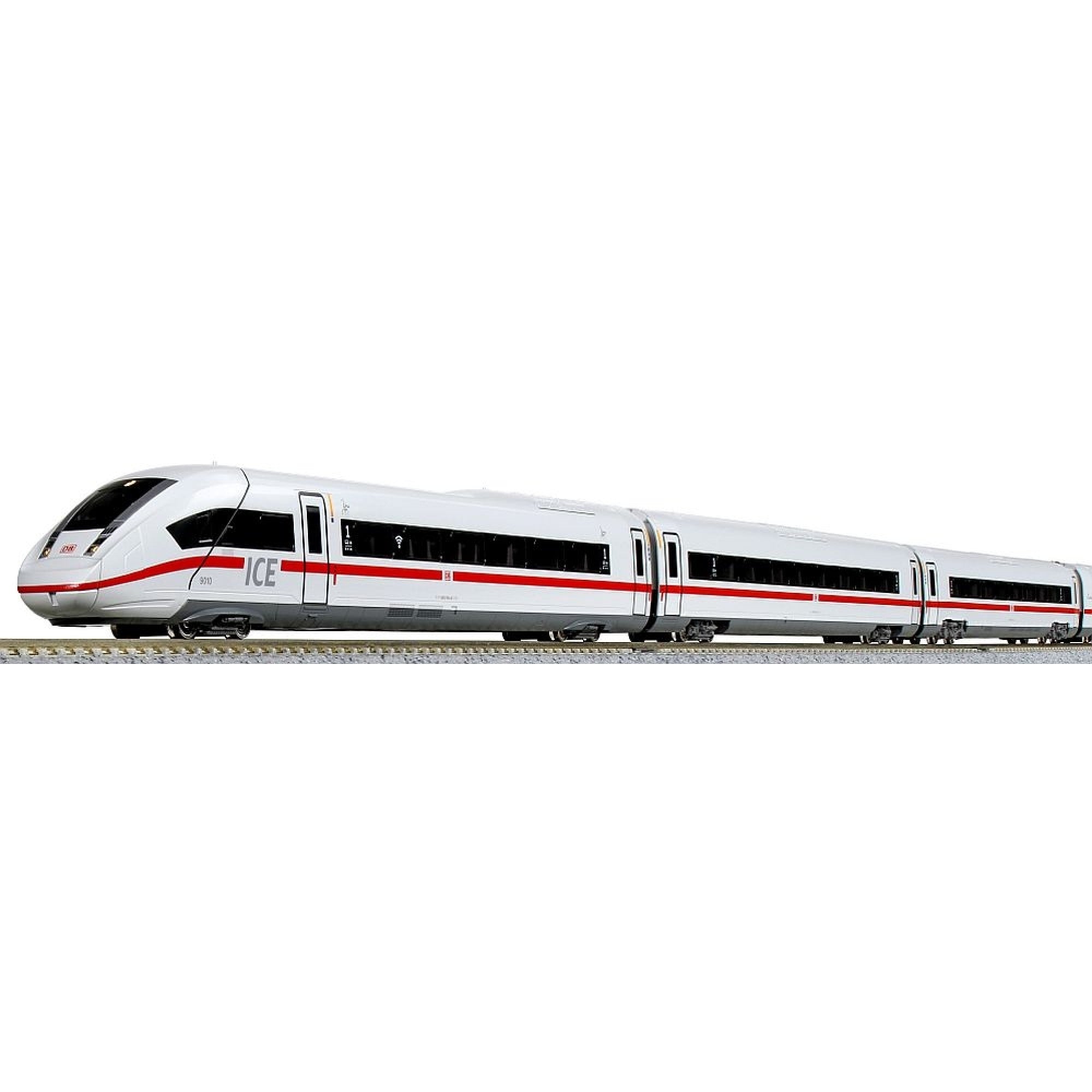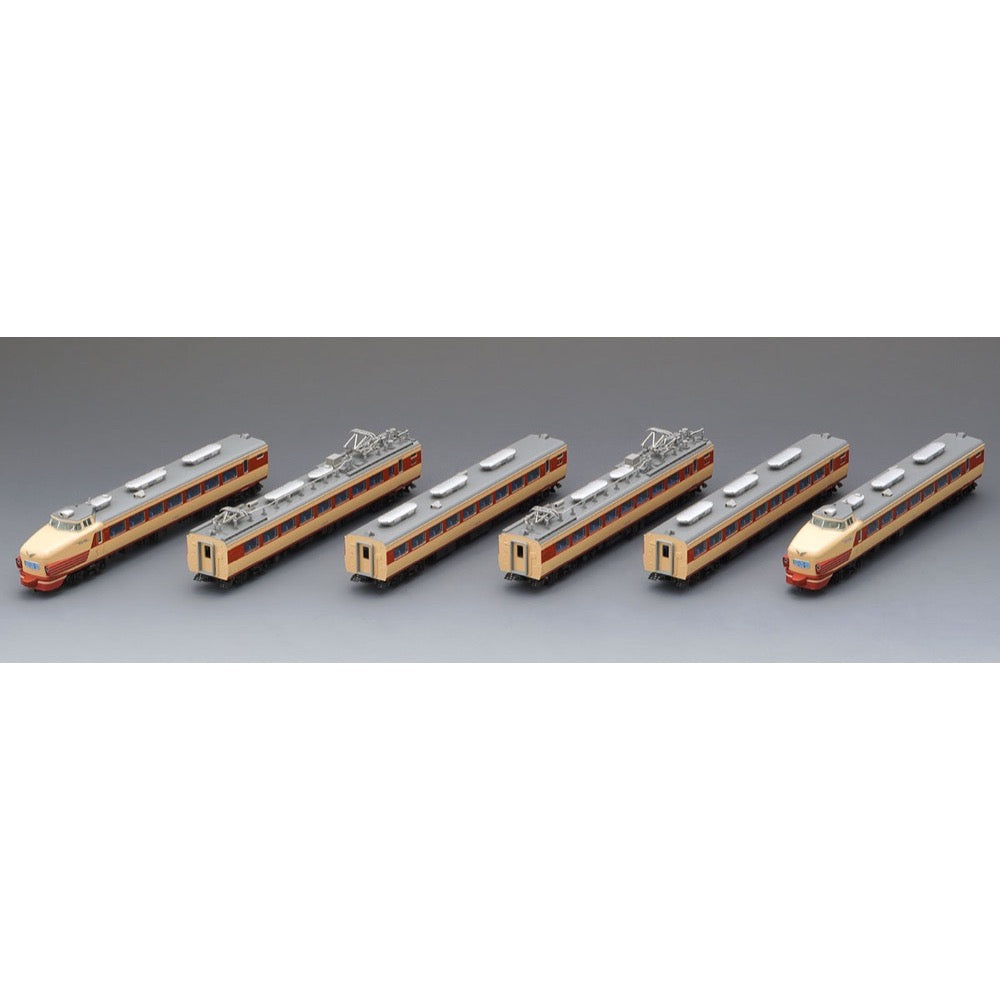
Tomix 98825 N 485 Limited Express Hitachi Basic Set 6cars
The 485 series is a representative express train for AC/DC powered trains of the Japanese National Railways.
When the 485 series trains that ran on the Hitachi were assigned to the Katsuta Depot, they were collected from Aomori, Sendai, Mukomachi, Minami-Fukuoka, and Kagoshima, and many of the trains were early models except for the Saro 481, making them well-equipped trains that were reminiscent of the golden age of express trains.
The KuHa 481 series trains transferred from the Kyushu region continued to run for a while, with their distinctive red skirts with a cream stripe at the base, which indicates that they were 60Hz AC trains, and the omission of the whiskers on the bonnet, even though the Joban Line north of Toride is a 50Hz AC section.
Features
- High grade (HG) specifications
- Kuha 481 type reproduces the appearance of a beardless red + cream stripe skirt
- Moha 484 type reproduces the appearance of seven insulators with a new production
- The side emergency exits of Moha 484 type and Moha 485 type are reproduced as non-unit type
- The roof is reproduced in gray, and the AU12 type cooler is reproduced in silver
- H rubber is reproduced in gray
- Car number and JR mark are selectable and a transfer sheet is included
- JNR mark is printed
- Printed train mark "Hitachi (illustration)" is attached, "Hitachi (letter) " includes ATS on-board sub parts
- Head and tail lights and train marks are equipped with a constant-on board and ON-OFF switch
- Head and tail lights and train marks are illuminated by incandescent LEDs
- The train mark lights up in a color close to white thanks to the use of a color prism
- TN coupler (SP) with piping is standard equipment on the connecting surface side
- Toilet tank is already installed
- Uses power with flywheel
- Uses new current collection system and black wheels
- Uses M-13 motor.
Contents
Vehicles
- Kuha 481-0
- Moha 484 (early model, 7 insulators, T)
- Moha 485 (early model)
- Moha 484 (early model, 7 insulators, M)
- Moha 485 (early model)
- Kuha 481-0
Accessories
- Runner parts: Express train symbol mark
- Runner parts: Antennas, etc.
- Runner parts: ATS on-board unit
- Parts: Bogie snowplow
- Parts: Train mark
- Transfer sheet: Car number
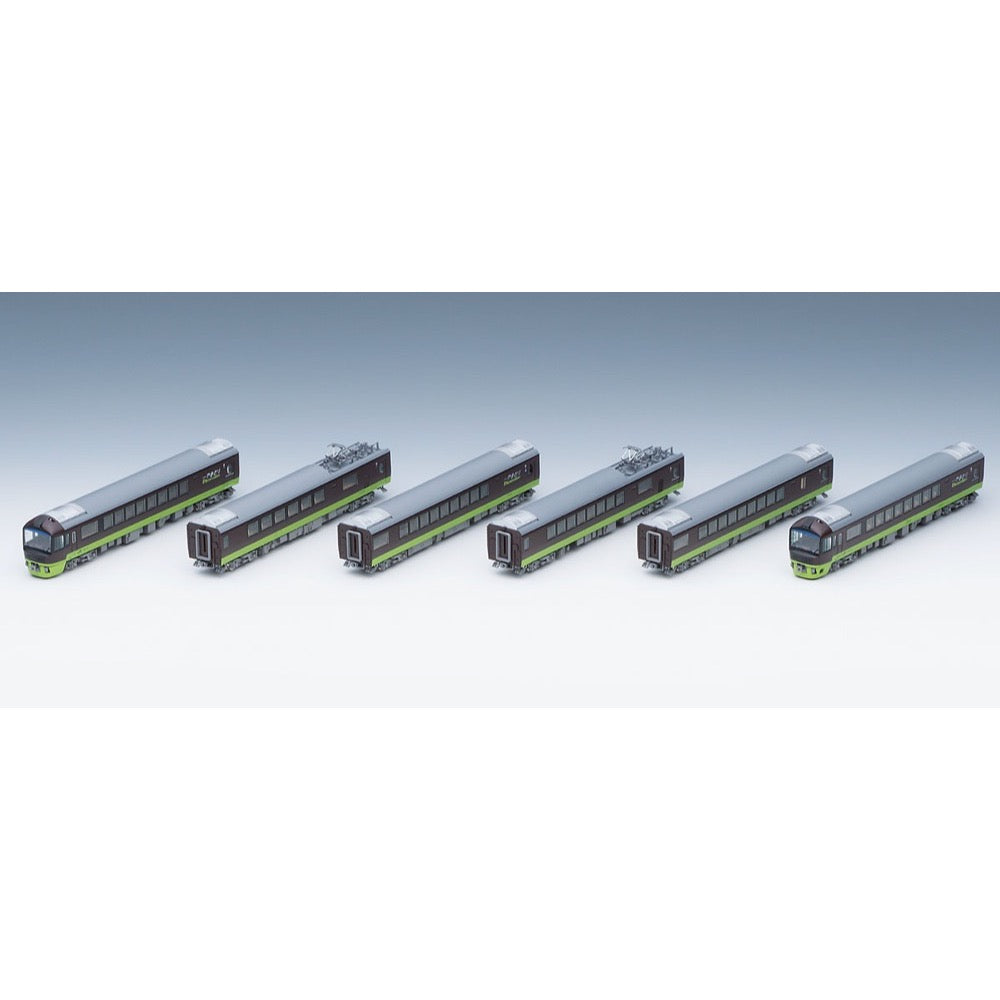
Tomix 98822 N 485-700 Train Resort Yamadori set 6 cars
The 485 series is a limited express train that was introduced in 1968 and is compatible with direct current and 50Hz and 60Hz alternating current, which is representative of the Japanese National Railways. In the 1990s, many Joyful Trains of the same series were introduced, which were modified or newly built based on the 485 series, as a replacement for the passenger car type Joyful Trains that had been in service up until now.
The Resort Yamadori was introduced in 2011 to coincide with the Gunma Destination Campaign as a new "fun train to ride". The train was a re-modification of the previously used tatami-mat train 485 series Yamanami and Seseragi, with the exterior of the car body painted grape-colored No. 2 and deep light green, and the interior was changed from tatami-mat to seats. It was mainly used on the Agatsuma Line's limited express "Resort Kusatsu" and rapid "Resort Yamadori" bound for tourist spots, and the Joetsu Line's rapid "Tanigawadake Mogura" and "Tanigawadake Loop" trains that traveled around the border area. While other 485 series trains were being retired, in her later years she continued to work alongside the 485 series Utage and Hana, which were transferred to her as colleagues, but Utage will be retired on February 23, 2019, Hana on October 31, 2022, and the last remaining Resort Yamadori will be retired on December 11, 2022. With the retirement of Resort Yamadori, the "485 series", which has been in service for a long time since the days of Japanese National Railways through the Showa, Heisei, and Reiwa eras, has been retired altogether.
Features
- High Grade (HG) specifications
- Newly produced reproduction of the 485 series 700th generation Resort Yamadori, which was mainly active in the metropolitan area
- Head and tail lights and front display section are equipped with constant lighting boards
- Headlights light up in warm white, tail lights light up in red
- Signal flares already installed
- Shoe rails, door rails, and car number are printed
- Front display section is optional and stickers are included
- Toilet tanks for KuHa 484, 485-703 and MoHa 484-704 are newly produced and already installed
- Uses power with flywheel
- New current collecting system, silver wheels
- Uses M-13 motor
- Each coupling side is equipped with a dummy coupler
- Each coupling side is equipped with TN couplers (SP) with piping as standard
Special Notes
Since the underfloor of MoHa 484 and 485 types reuses that of the existing 485 series, some parts differ from the actual vehicles.
Contents
Vehicles
- Kuha 484-703
- Moha 484-703(M)
- Moha 485-703
- Moha 484-704
- Moha 485-704
- Kuha 485-703
Accessories
- Sticker: for front display
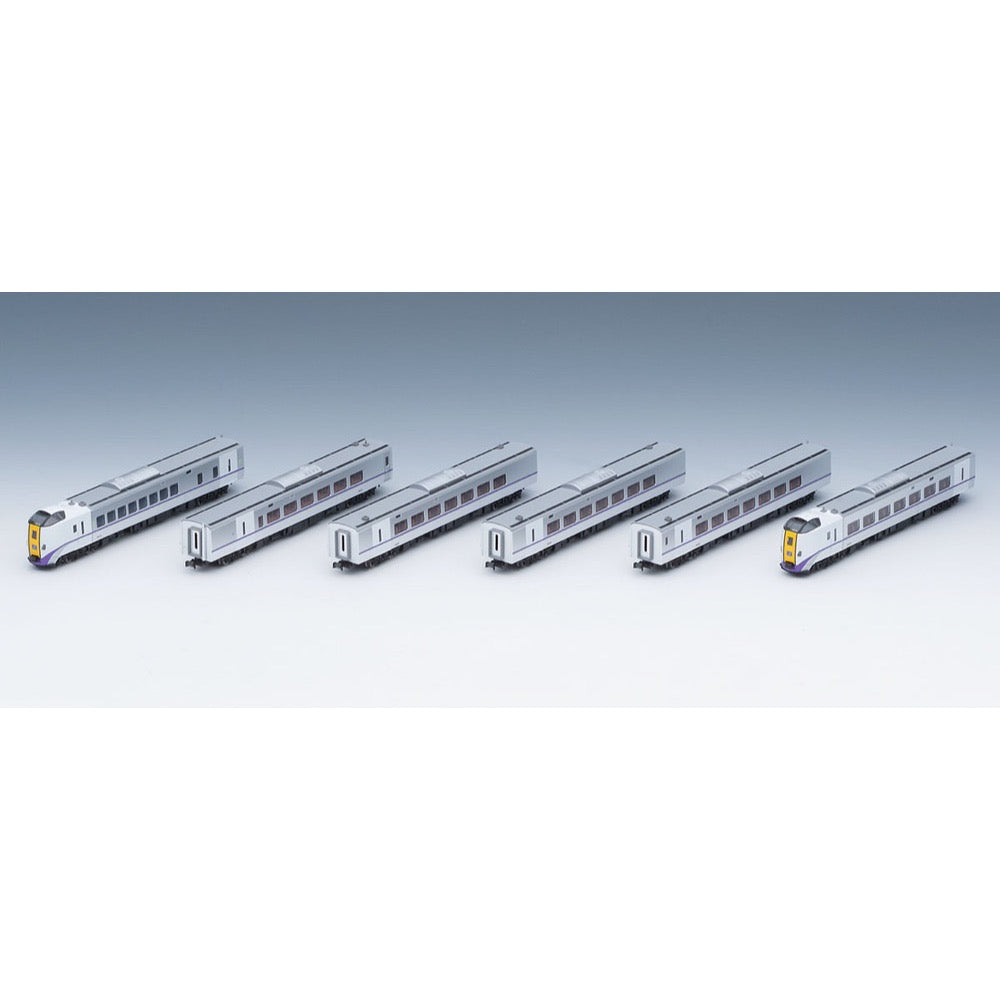
Tomix 98838 N KIHA 261-1000 LTD Express Diesel car set 6cars
The Kiha 261-1000 series is a limited express diesel car of JR Hokkaido that was introduced in 2006.
The 7th series, which was introduced in 2018, has changed the surface finish of the outer panels and the joints, and the Kushiro-based cars of the limited express "Ozora", all of which will be Kiha 261 series trains in 2022, will be basically made up of 7th series cars.
Features
- Reproduces the feature of the 7th series car, which has no seams above the side windows and beads on the end faces as in the actual car
- The skirt at the front reproduces the shape with the slits for the electronic horn
- The expression of the stainless steel body is reproduced with the same shiny silver paint as the
- Kiha 261-5000 series ``Hamanasu'' and ``Lavender''
- The printed train mark ``OZORA'' is already installed, and ``HOKUTO/TOKACHI'' is included
- The head and tail lights and train mark are equipped with a constant lighting board and an ON-OFF switch
- The head and tail lights and train mark are lit by white LEDs
- The green car mark of the KiRo 261 type is printed
- The car number is selectable and a transfer sheet is included
- Uses a flywheel-equipped power source, a new current collecting system, and black wheels
- Uses an M-13 motor
Vehicles
- Kiro 261-1100 (7th series)
- Kiha 260-1100 (7th series) (M)
- Kiha 260-1300 (7th series)
- Kiha 260-1300 (7th series)
- Kiha 260-1200 (7th series)
- Kiha 261-1200 (7th series)
Accessories
- Runner parts: Train mark
- Parts: Snowplow
- Transfer sheet: Car number
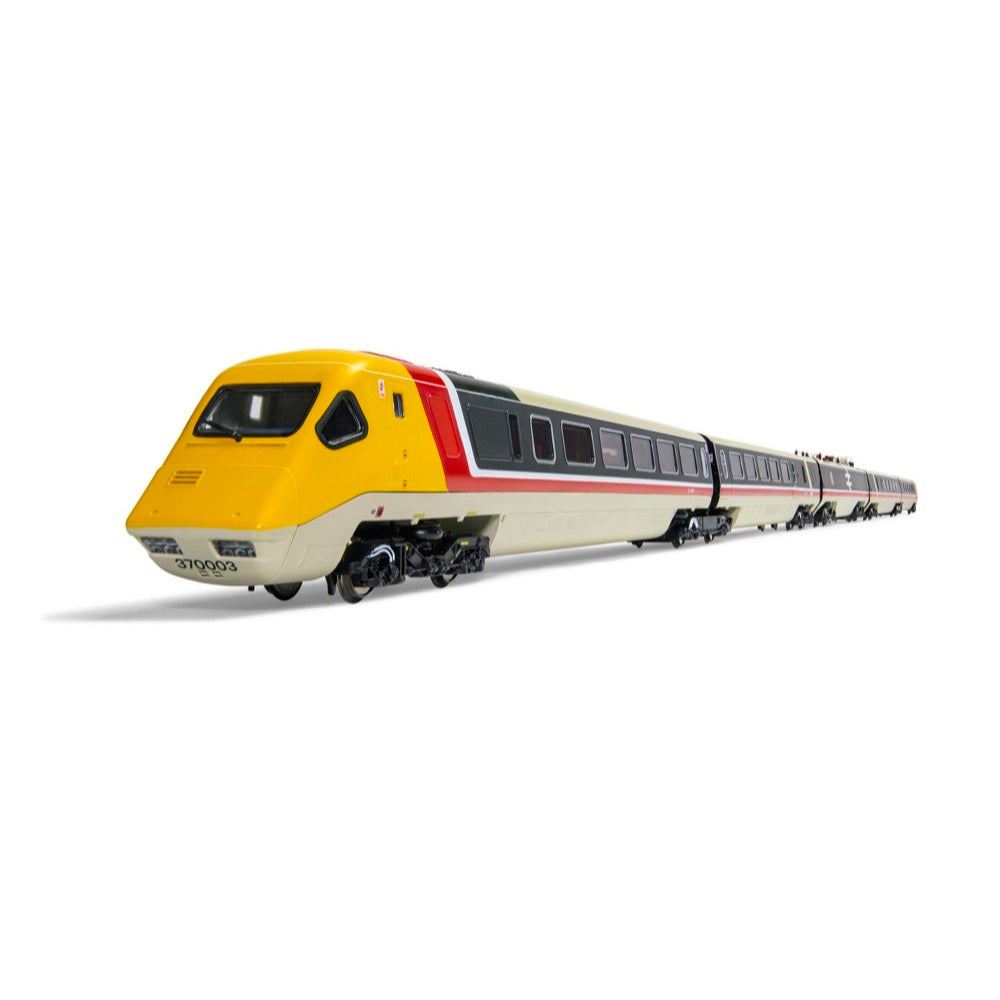
Hornby R3873 OO BR Class 370 Advanced Passenger Train 5-car Train Pack
Featuring an impressive set of passenger cars consisting of two driving units, two coaches and a non-driving motor unit, the APT 5-car pack encapsulates the historical character of the Advanced Passenger Train in its many forms. With a number of failures and successes, the APT is a thought-provoking addition to any model railway layout.
British Rail Class 370 Advanced Passenger Train 5-car Pack Set 370 003 comprising DTS Sc48103, TBF Sc48603 and NDM Sc49003 City of Derby, along with Set 370 004 comprising TBF Sc48604 and DTS Sc48104. By the end of 1970 the British Rail Board began considering the third design phase of the Advanced Passenger Train; the prototype for the full production trains that would incorporate the technology of the APT-E in a practical application.
From the outset the pre-production APT project, or APT-P, was considered to be nothing more than a proving prototype for evaluation, prior to the finalized Advance Passenger Train design being authorized for squadron service; the APT-S. Having settled on electric traction for the production APT, the West Coast main line between Euston and Glasgow was the obvious route for conducting testing, being electrified along its length and with some severe curves that curtailed high speed travel. The date for commencement of services was set for 1977 and the Chief Mechanical and Electrical Engineers' Department (CM&EE) design engineers began work in October 1973. In a move similar to the current situation of the DfT defining design specifications, it was the passenger business of British Rail that decided upon the original configuration for the APT-P. Each set was to comprise fourteen cars, with the two power cars marshalled at the outer ends of the sets.
It soon became clear that the use of two pantographs, one on each power car, was unsuitable for the OHP wires in place at that time and the use of two power cars in the middle of the train became the only option, effectively cutting the train in half. This created two 1+6 formations of DTS, TS, TRBS, TU, TF, TBF and NDM (Non-Driving Motor), through which passengers could not pass due to the high magnetic fields generated by the electrical equipment contained in the NDM. The NDM was the first vehicle completed for testing in June 1977 and it spent a year on static tests at RTC Derby, as well as dynamic tests on the WCML with a spare HST Power Car from September 1977.
In mid-1978 the power car was joined by the rest of the first half set for testing on the WCML and was unveiled to the press on June 7th but, hampered by industrial action, it was to be February 1979 before various formations of the full train were marshalled to test different aspects of the train. At the end of the year on December 20, 1979, a new rail speed record of 162.2mph was achieved and by March 1980 all three APT-P trains were delivered and ready for mileage accumulation on the WCML.
Having finally achieved full route clearance and with testing indicating that all was progressing to plan, shadow passenger service was set to commence on June 9, 1980 with a daily Glasgow/London return service. A demonstration run on April 18th with a 1+9 set was meant to usher in a new era of high speed rail travel, but a derailment caused by a faulty articulated bogie signaled the beginning of the APT 'jinx' and the postponement of passenger introduction. Wheelsets had to be rebuilt across the fleet and reliability problems with the tilt, transmission and braking systems were also exacerbated by the mediocre ride quality. It was also found that failure of the tilting mechanism could result in the APT exceeding its kinematic envelope and potentially coming into contact with an APT travelling in the opposite direction.
It was to be Spring 1981 before main line testing could resume and by now media and public opinion was turning against the project, with some individuals in Government and within the British Railways Board expressing their discontent as well. Entering public service on December 7, 1981 at first all went well, but very cold weather in Scotland on December 9th and again on December 11th resulted in the brakes freezing and the APT being taken out of traffic until the summer of 1982. A year of technical R&D project running followed, before limited passenger running took place across 1983/84 to assess passenger comfort using the full 2+12 sets between London Euston and Glasgow, culminating in a new time and speed record for the 401 mile trip of three hours and fifty-two minutes; an average speed of 103mph.
Far exceeding its budget, APT-P had now effectively reached the end of its development program. Although a number of plans had been suggested for the implementation of APT in service, in a number of formations and with varying traction options, the APT-S, APT-R, APT-T, APT-U and APT-V projects never materialized. The fleet of six sets had been reduced since March 1983, parts being canonicalized to keep the remaining vehicles running and at the end of May 1985 the APT-P was withdrawn from service, with the Intercity Development Train (APT-D) continuing until December 1986.
Includes
- 5x Locomotive Diesel
Technical Specifications
- Item Length - Without Packaging (cm): 27.6
- Item Height - Without Packaging (cm): 5
- Item Width - Without Packaging (cm): 3.5
- Item Weight - Without Packaging: 0.14
- Item Scale: 1:76 Scale 00 Gauge
- License: No
- Finish: Painted
- Colour: Grey
- Gauge: OO
- DCC Status: DCC Ready 8 pin socket
- Operator: BR
- Designer: BREL
- Livery: Intercity Executive
- Minimum Curve (mm): Radius 2
- Motor: 5 Pole Skew wound
- Number of Parts: 5
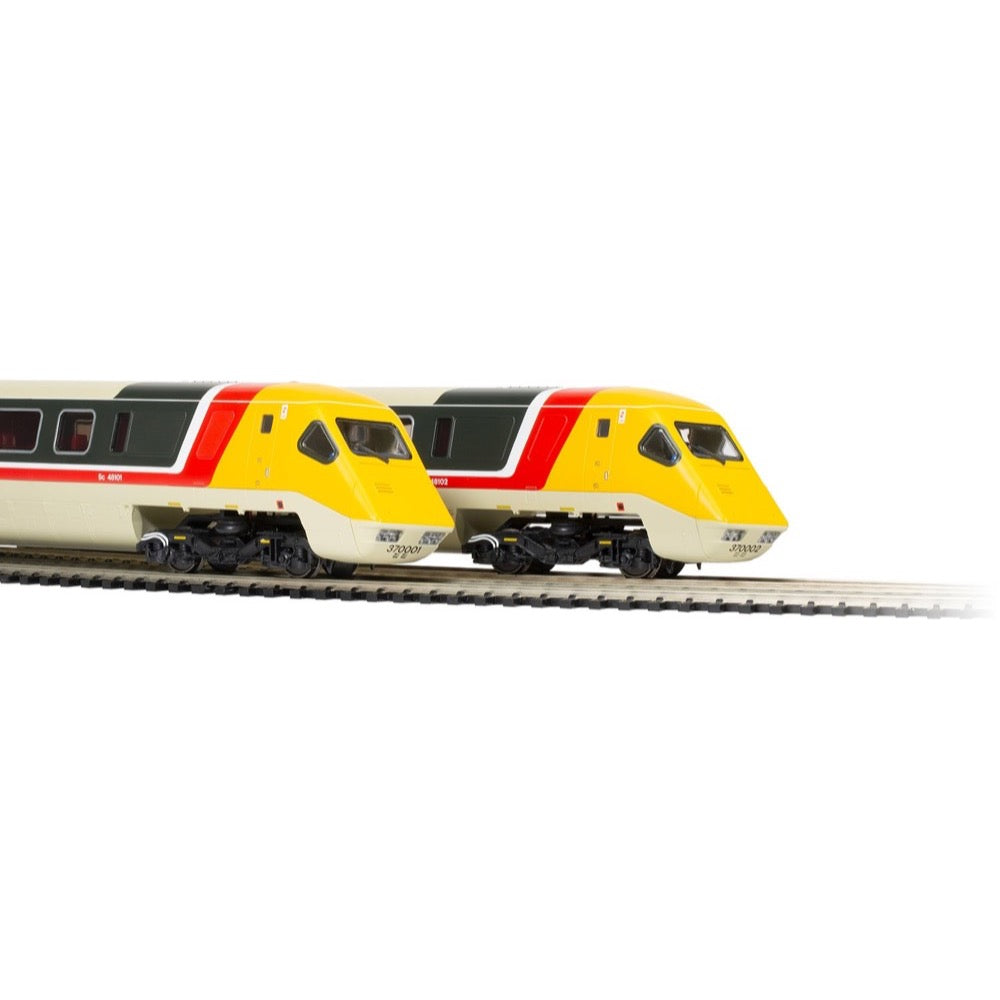
Hornby R30104 OO BR Class 370 Advanced Passenger Train Sets 370001 and 370002 5-car Pack
Our newest model replicas of the Advanced Passenger Train are our best yet. Following feedback on our older designs, we’ve remoulded this iconic train and created a model that faithfully represents the original.
The R30104 is a highly detailed update of an old favourite. Eagle-eyed hobbyists will notice the improved NDM motor pivot mounts, the redesigned cab for enhanced accuracy, the strengthened pantograph, and the redesigned lighting PCB.
We’ve also added a few upgrades of our own. Magnetic couplings and crew figures make for a more enjoyable model railway experience. And, of course, you’ll love our improved 21-pin decoder fitment and HM7000 compatibility.
Download the HM|DCC app to get the most out of your APT!
History
The idea behind the APT was solid. Engineers wanted to create a train that was faster and more efficient than anything else available at the time. Their plans were ambitious – the trains included a computerised tilting system that could effortlessly navigate the tight turns of Britain’s ageing railways, speeding up journeys by 40%!
The first APT-P rolled onto the railways in 1979. They were continuously developed until 1987, with mixed reactions, including a period of passenger service between 1983 and 1985. When the cheaper IC125 HST made its way onto the tracks, the APT was withdrawn, deemed too unreliable, expensive, and complex to compete.
But the APT legacy continues. The IC225 programme used elements from the design, as did the world-famous tilting Alstom Pendolino trains that still operate today on the West Coast mainline.
Specification
- Item Length - Without Packaging (cm): 27.6
- Item Height - Without Packaging (cm): 5
- Item Width - Without Packaging (cm): 3.5
- Item Weight - Without Packaging: 0.14
- Item Scale: 1:76 Scale 00 Gauge
- Finish: Painted
- Colour: Magnolia
- DCC Status: DCC Ready 21 pin socket
- Operator: BR
- Designer: BREL
- Livery: APT
- Minimum Curve (mm): Radius 2
- Motor: 5 Pole Skew wound
- Number of Parts: 5
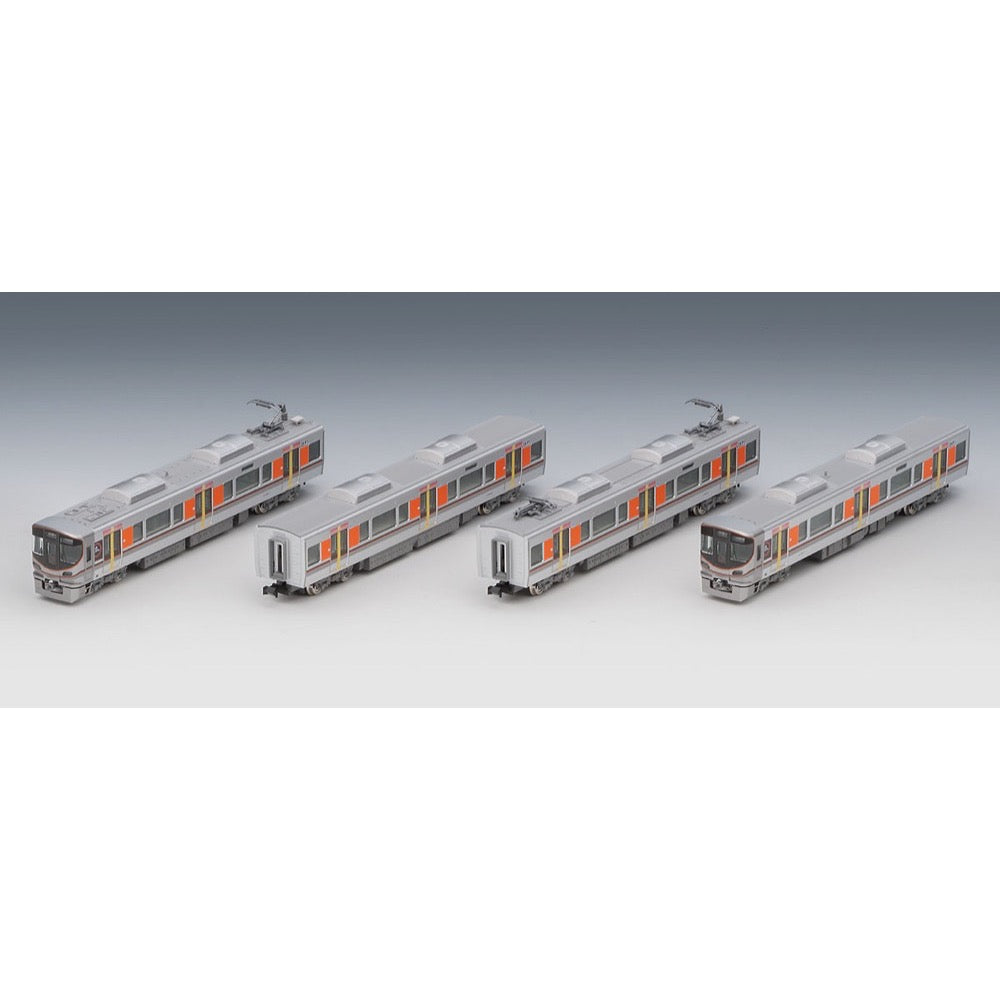
Tomix 98580 N 323 Commuter Train Osaka Kanjo Line Basic Set 4 cars
The 323 series was introduced in 2016 as a train exclusively for the Osaka Loop Line. It is in service on the Osaka Loop Line and JR Yumesaki Line. There are currently 22 trains, 176 cars, in operation. Trains decorated for the Osaka-Kansai Expo are also in operation.
Features
- 323 Series Osaka Loop Line has been renewed
- By combining this product with <98581>, an 8-car formation can be recreated
- The front display is fitted with the printed part "Regular Osaka Loop Line"
- The front display is compatible with replacement parts (use the ones included in the add-on set)
- Car number is printed
- JR mark, logo mark, wheelchair mark, and shoe prints are printed
- Head and tail lights and front display part are white LEDs, and fog lights are reproduced with orange lighting using color prisms
- The driver's side of the leading car is equipped with a dummy coupler
- Uses a power source with a flywheel
- Uses a new current collection system and silver wheels
- Uses an M-13 motor
- Uses a hanging-style paper package
Contents
Vehicles
- KuMoha323-17 (Car No. 8)
- Moha322-65 (M) (Car No. 7)
- Moha323-34 (Car No. 2)
- KuMoha322-17 (Car No. 1)

Tomix 98568 N 185-0 LTD Express Odoriko Enforced Skirt Addon Set 5 cars
The 185 series is a direct current express train that began operation in 1981. Its color scheme is cream No. 10 with a diagonal stripe of green No. 14. The skirt has been changed to a reinforced type since around 2010.
Features
- High grade (HG) specifications
- Car numbers are selectable and compatible with transfer sheets (use the ones included in the basic set)
- Green car mark, shoe marks, and door rails are printed
- Toilet tank is already installed
- New current collection system and black wheels are used
- TN couplers (SP) with piping are standard equipment between each connecting surface
Contents
Vehicles
- Moha 184-0
- Moha 185-0
- Salo 185-0
- Moha 184-0
- Moha 185-0
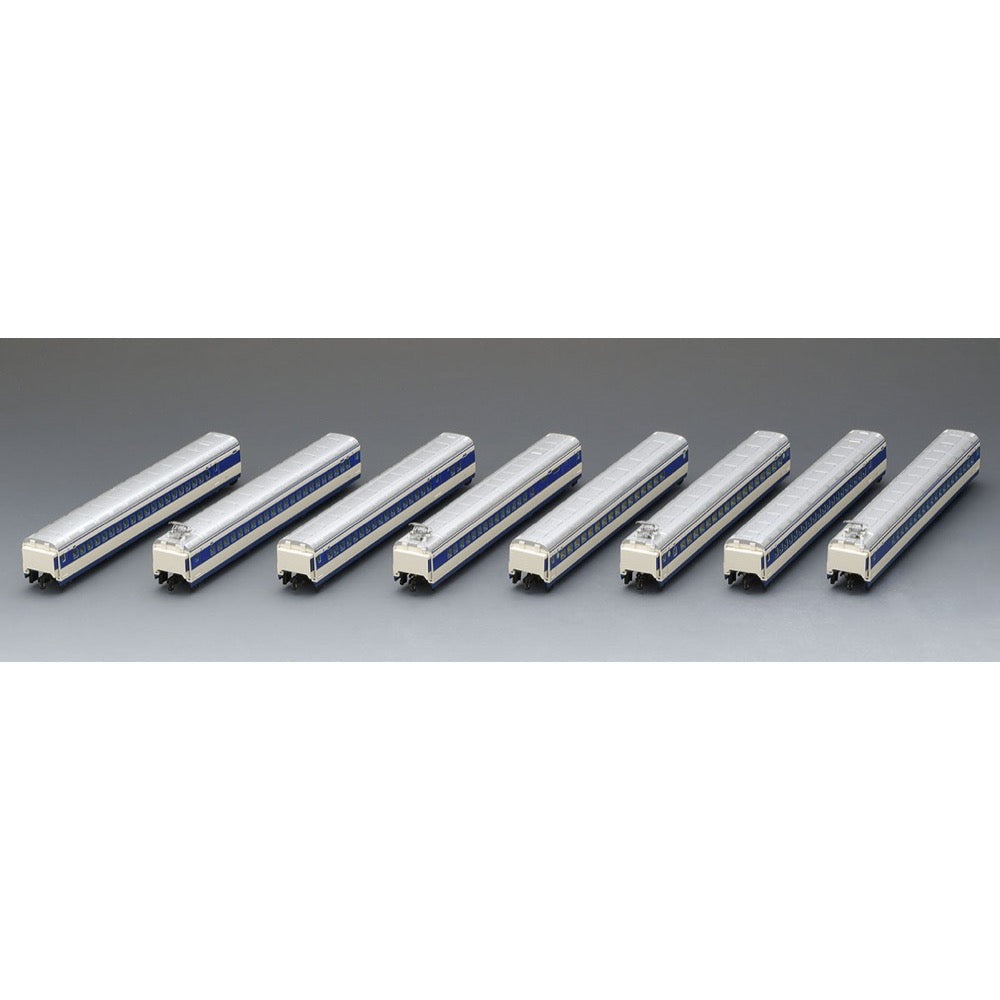
Tomix 98886 N 0-1000 Tokaido Sanyo SHINKANSEN Basic Set 8 Cars
The 0 series was the first commercial Shinkansen train to appear in 1964.
The 1000 series, with its smaller side windows, was introduced to replace the earlier cars with larger windows that were mixed in with the trains, but at the time, three trains made up of the 1000 series were introduced as spares, boasting the beauty of a uniform train with small windows.
Features
- Add-on set that, when combined with the <98885> basic set, can recreate the N97-N99 formation, in which all 16 cars are the neatly aligned 1000 series with small windows
- Set of 8 cars, 5, 6, 7, 8, 11, 12, 13, and 14, with each car number printed on it
- The seats in the ordinary cars are gray, while the 15 and 16 series green cars have yellow seats
- The seats in the dining car 36-1000 series recreate the dining room table, kitchen equipment, and partition from the corridor
- The car number is selectable and compatible with transfer sheets (transfer sheets are included in the basic set)
- The green car mark of the 15 and 16 series green and the frame around the door are printed in gold
- Uses a motor with a flywheel
- Uses a new current collecting system and silver wheels
- Uses hook and U-shaped current-carrying couplers
- Uses an M-13 motor
Contents
Vehicles
- 25-1700
- 26-1200 (M)
- 27-1000
- 36-1000
- 15-1000
- 16-1000
- 25-1000
- 26-1000
Accessories
- Runner parts: Insulators
- Parts: Powered bogie mounting auxiliary rod
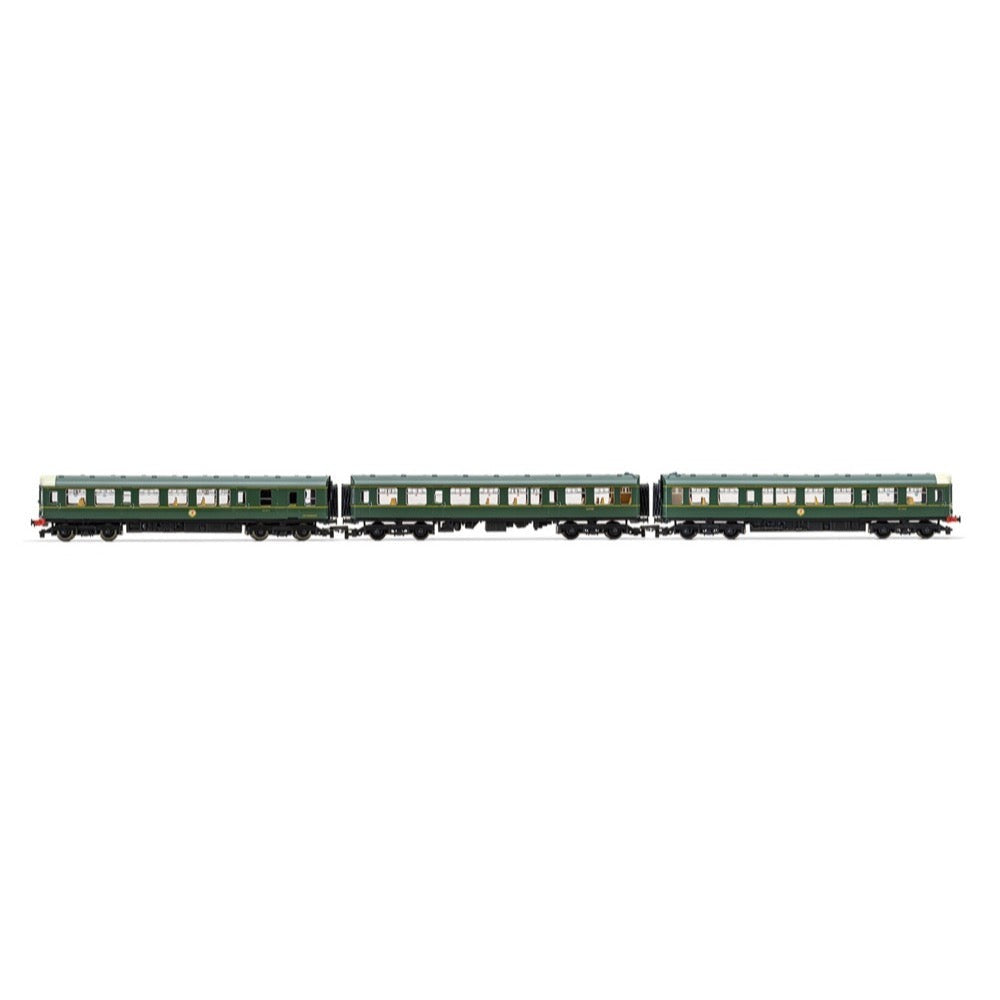
Hornby R30170 OO RailRoad Plus BR Class 110 3 Car Train Pack
Designed to deal with the steep gradients of the Calder Valley route, the Class 110 was distinctive in being the first generation DMU with the highest power to weight ratio of any naturally aspirated unit. In 1982 the middle trailer car was removed from most sets to reduce maintenance costs and further improve acceleration. Exactly one of each, a two car and a three car have been preserved.
Specification
- Item Length - Without Packaging (cm): 72.6
- Item Height - Without Packaging (cm): 5
- Item Width - Without Packaging (cm): 3.5
- Item Scale: 1:76 Scale 00 Gauge
- Finish: Painted
- Colour: Green
- DCC Status: DCC Ready 8 pin socket
- Operator: BR
- Designer: Birmingham Railway Carriage and Wagon Company
- Livery: BR Green
- Minimum Curve (mm): Radius 2
- Motor: 5 Pole Skew wound
- Number of Parts: 1
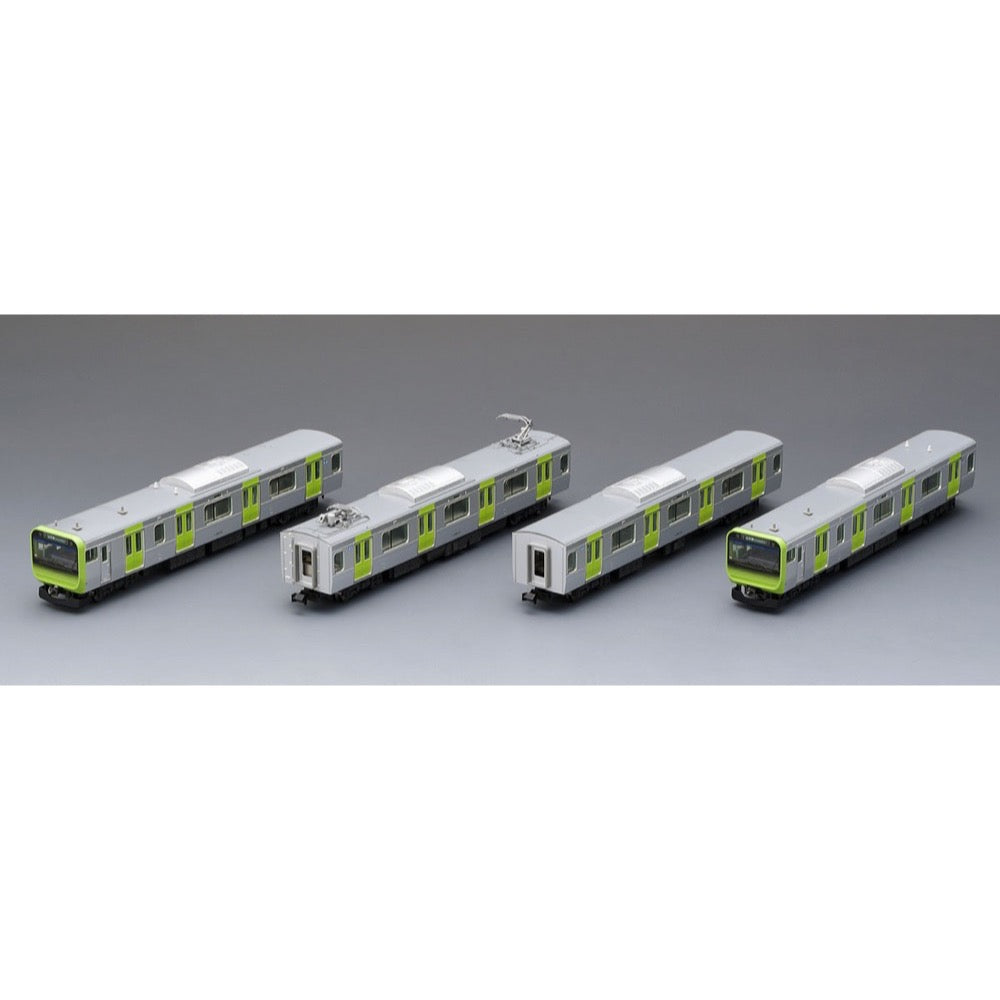
Tomix 98525 N E235-0 Train Late Type Yamanote line Basic 4 cars pack
The E235 series is a new commuter train that was introduced on the Yamanote Line in March 2015.
50 sets of this series will be introduced by 2020, replacing the conventional E231 series.
The bead shape of the roof has been changed since the set that appeared around 2018.
Features
- Reproduces the later model of the E235-0 series with thinner roof beads
- The distinctive door line color is reproduced by printing
- Car number printed
- JR mark printed
- Side glass reproduces green glass
- Head and tail lights and front display unit are equipped with a constant lighting board
- Head and tail lights and front display unit are lit by white LEDs
- Front display unit is equipped with a printed part "Yamanote Line"
- Only the driver's cab side of the leading car is equipped with a dummy coupler
- Uses a power source with a flywheel
- Uses a new current collection system and black wheels
- Uses an M-13 motor
Vehicles
- Kuha E235-45
- Moha E235-134(M)
- Moha E234-134
- Kuha E234-45
Accessories
- Runner parts: antenna
- Runner parts: lightning arrester
- Runner parts: radio antenna
- Runner parts: signal flare
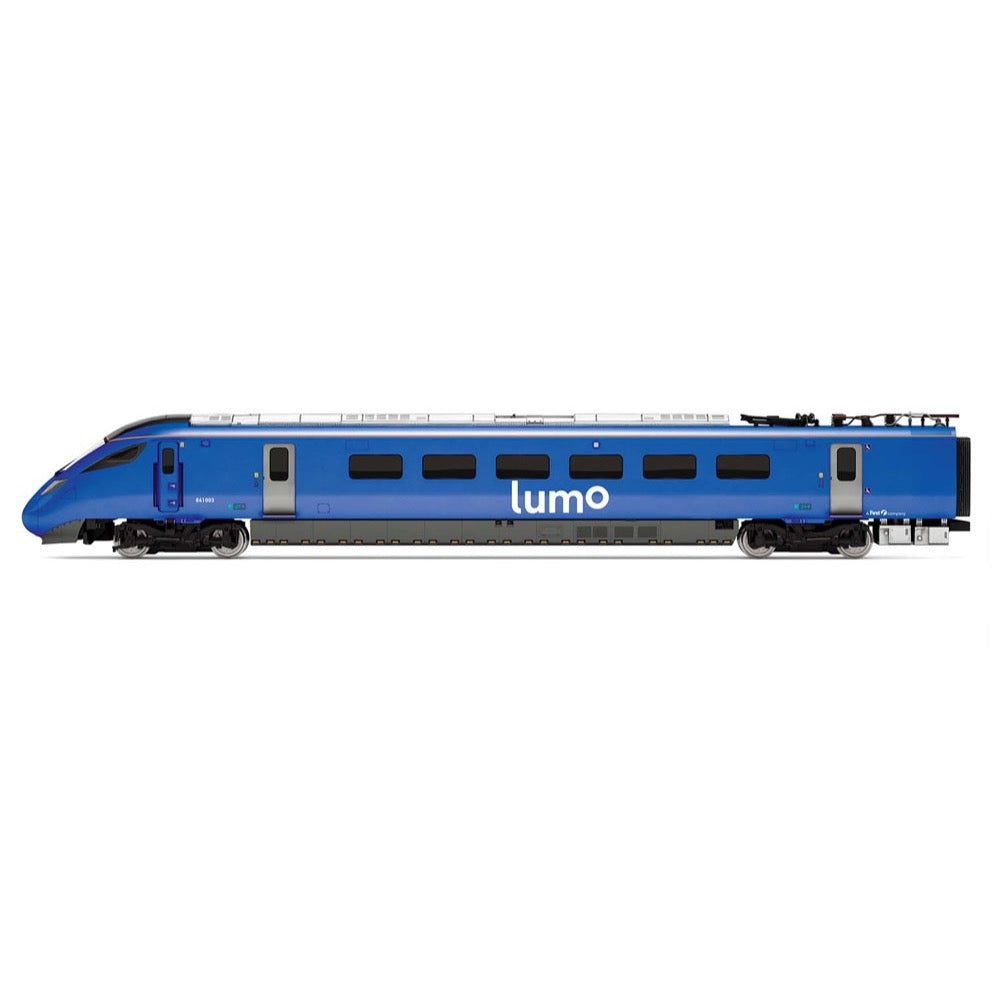
Hornby R30102 OO Lumo Class 803 803003 Five Car Train Pack
The Class 803 AT300 is a new type of electric multiple unit passenger train built by Japanese rolling stock manufacturer Hitachi at their Newton Aycliffe factory in County Durham, based upon the Hitachi A-train design. While sharing a bodyshell with the previous UK A-train variants, the Class 803 differs in that it has no auxiliary diesel engines fitted. Batteries are fitted to power the on-board facilities in case of overhead line equipment failure.
The first bodyshell arrived from the facility in April 2020. Testing for the new Class 803 units took place overnight from 26 May to 27 May in 2021. A GBRf liveried Class 66 locomotive, No. 66751 ‘Inspiration Delivered – Hitachi Rail Europe’, hauled 803001 into Darlington on test. Three round trips from Darlington to York were completed overnight and ran as the following services:
- 5Q70 2258 Darlington to York
- 5Q71 0028 York to Darlington
- 5Q72 0128 Darlington to York
- 5Q73 0234 York to Darlington
- 5Q74 0335 Darlington to York
- 5Q75 0428 York to Darlington
With testing completed and the units being deemed ready, the 'Lumo' service commenced on 25 October 2021 with two trains per day travelling from London to Edinburgh in each direction on normal weekdays. However, it was scheduled to be increased to five per day during 2022. It was anticipated that the fastest service would complete the journey in 4 hours 3 minutes, although most would take a little over 4 hours 30 minutes.
The unit’s top speed is 140mph but are limited to a maximum of 125mph on the main line. ‘Lumo’ serve the East Coast Main Line from London King’s Cross to Edinburgh Waverley with Stevenage, Newcastle, and Morpeth as in between stations on the route. The aim is for passengers transported on the ECML to experience comfort whilst paying low fares for train tickets.
The units are numbered from 803001-803005, with 803005 being the only named unit: ‘Proudly from Newcastle the home of Stephenson's Works bicentenary 1823–2023’. Each unit contains four hundred seats, with fifty-two seats as priority seats and two wheelchair spaces. Standard class seating is prevalent throughout and fitted with extendable tray tables, reading lights and easily accessible power sockets for charging devices.
As of 2024, FirstGroup applied for a new open access service between Rochdale and London. They propose to run six return journeys per day from Rochdale to London Euston via Manchester Victoria on the Lumo Class 803 units. Manchester Victoria, Eccles, Newton-le-Willows, and Warrington Bank Quay would be stations called upon along the route. It is hoped that services can begin in 2027.
This train pack represents the only named unit of the Lumo Class 803, No. 803005, and is resplendent in a vivid blue Lumo ‘Net-Zero Champion’ livery. Directional lighting and cab lighting are available for the power car. The accurate corridor connections on each car have tinted glazing. DCC Ready with a 21-pin socket, the 5 pole skew wound motor enables smooth running and great traction.
Specification
- Item Length - Without Packaging (cm): 34
- Item Height - Without Packaging (cm): 5
- Item Width - Without Packaging (cm): 3.5
- Item Weight - Without Packaging: 0.18
- Item Scale: 1:76 Scale 00 Gauge
- License: Yes
- Finish: Painted
- Colour: Blue
- DCC Status: DCC Ready 21 pin socket
- Operator: Lumo
- Designer: Hitachi
- Livery: Lumo Class 803
- Minimum Curve (mm): Radius 2
- Motor: 5 Pole Skew wound
- Number of Parts: 1


